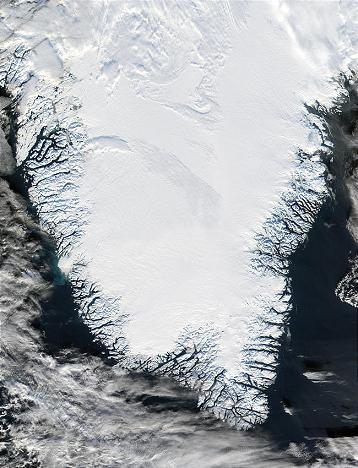Researchers who examined satellite photographs claim that the ice sheet on the world's largest island is rapidly disappearing * In March of this year, a similar study was published that showed that the Antarctic ice sheet is also melting rapidly
Avi Blizovsky and the news agencies

Analysis of data from twin satellites showed that the melting of the Greenland ice shelf has been accelerating dramatically in recent years, with most of the ice loss occurring mainly along one of the coasts that is apparently affected by the warming of Western Europe.
This is the southeast coast of the island, where during the last two years the ice has melted more than in the year and a half before that. The dramatic changes were discovered during the study of the Greenland ice mass between 2002 and 2005 conducted by the University of Texas at Austin in collaboration with researchers from the University of Arizona.
About 232 cubic kilometers of ice are lost every year. Greenland's glaciers store ten percent of the fresh water on Earth. This melting of ice contributes about half a millimeter to the global rise of the sea level.
According to NASA data, the rate of ice disappearance has accelerated since 2004. According to the accepted estimates, if the Greenland ice sheet disappears completely, the global sea level is expected to rise by 6.5 m. According to the conclusions that emerge from the data, and which are published in the monthly "Science", the ice is melting at a particularly high speed in southeast Greenland.
The researchers examined the monthly changes in the Earth's gravity between April 2002 and November 2005. The data were obtained from the "Grace" satellite, which was launched in 2002 with the purpose of conducting experiments on gravity and climate. The data obtained made it possible to assess the changes in the ice mass on top of Greenland.
According to the researchers' estimates, the ice sheet in Greenland is melting at a rate of about 239 cubic kilometers per year. This is a number 3 times higher than the earlier estimates, which were based on the data from the first two years of Grace's stay in space. According to the researchers, the change in estimates is partly based on the data from the last 18 months and partly on improved processing of the data from "Grace".
"The acceleration of mass loss in Greenland, if it turns out to be real, is consistent with the estimates regarding the acceleration of global warming in recent years," the researchers wrote in their article. The researchers' findings are in good agreement with a previous study, which was based on data from other satellites and indicated similar data.
The study was published as mentioned last Friday in Science magazine. Similar results on a significant loss of ice in Antarctica were published in Science in March of this year by other researchers who participated in the GRACE Gravity Recovery and Climate Experiment (GRACE) project. The Grace mission is funded by NASA and the German Aerospace Center, and the project is headed by Prof. Byron Tapley.
